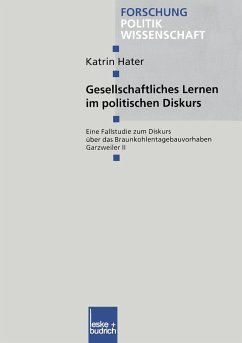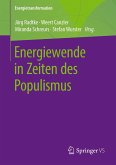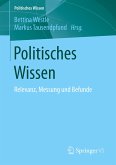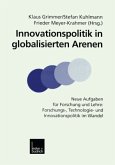1. 1 Ausgangspunkt der Untersuchung . . . . . . . . . . . . . . . . . . . . . . . . . . . . . . . . . . . . . . . . . . . . . . . . . 13 1. 2 Theoretische Bezüge . . . . . . . . . . . . . . . . . . . . . . . . . . . . . . . . . . . . . . . . . . . . . . . . . . . . . . . . . . . . . . . . . . . . 17 1. 3 Empirische Zugänge . . . . . . . . . . . . . . . . . . . . . . . . . . . . . . . . . . . . . . . . . . . . . . . . . . . . . . . . . . . . . . . . . . . . . 19 2 Theoretische Verortung der Fragestellung . . . . . . . . . . . . . . . . . . . . 21 2. 1 Gesellschaftliche Lernprozesse . . . . . . . . . . . . . . . . . . . . . . . . . . . . . . . . . . . . . . . . . . . . . . . . . . . . . 21 2. 1. 1 Garzweiler lI-ein Konflikt im Übergang zur postindustriellen Gesellschaft? . . . . . . . . . . . . . . . . . . . . . . . . . . . . . . . . . . . . . . . . . . . . . . . . . . . . . . . . . . . . . . . . . . . . . . . . . . . . . . . . 21 2. 1. 2 Gesellschaftliches Lernen als Bewältigung von Unsicherheit. . . . . . . . . 23 2. 1. 3 Gesellschaftliches Lernen und soziale Bewegungen . . . . . . . . . . . . . . . . . . . . . . 26 2. 1. 4 Die Produktion von Wissen . . . . . . . . . . . . . . . . . . . . . . . . . . . . . . . . . . . . . . . . . . . . . . . . . . . . . . . . . . 28 2. 1. 5 Das Aushandeln von sozialen Institutionen . . . . . . . . . . . . . . . . . . . . . . . . . . . . . . . . . . . 30 2. 1. 6 Die Bildung von sozialen Identitäten . . . . . . . . . . . . . . . . . . . . . . . . . . . . . . . . . . . . . . . . . . . . 31 2. 1. 7 Diskurse und gesellschaftliche Lernprozesse . . . . . . . . . . . . . . . . . . . . . . . . . . . . . . . . . 33 2. 2 Diskurs als Medium von Politisierung und Entpolitisierung . . . . . . . . . . . 34 2. 3 Politisches Handeln . . . . . . . .. . . . . . . . . . . . . . . . . . . . . . . . . . . . . . . . . . . . . . . . . . . . . . . . . . . . . . . . . . . . . . 37 2. 4 Definitionen . . . . . . . . . . . . . . . . . . . . . . . . .. . . . . . . . . . . . . . . . . . . . . . . . . . . . . . . . . . . . . . . . . . . . . . . . . . . . . . . . 40 Zweiter Teil: Das Handlungsfeld - physische Gegebenheiten, Akteure und Institutionen 3 Vorspann . . . . . . . . . . . . . . . . . . . . . . . . . . . . . . . . . . . . . . . . . . . . . . . . . . . . . . . . . . . . . . . . . . . . . . 43 3. 1 Das rheinische Braunkohlenrevier . . . . . . . . . . . . . . . . . . . . . . . . . . . . . . . . . . . . . . . . . . . . . . . . 44 3. 2 Eckpunkte des Diskurses über Garzweiler 11 . . . . . . . . . . . . . . . . . . . . . . . . . . . . . . . . . 45 3. 3 Diskurstraditionen . . . . . . . . . . . . . . . . . . . . . . . . . . . . . . . . . . . . . . . . . . . . . . . . . . . . . . . . . . . . . . . . . . . . . . . . 47 4 Der Bergbautreibende . . . . . . . . . . . . . . . . . . . . . . . . . . . . . . . . . . . . . . . . . . . . . . . . . . . 49 4. 1 Struktunvandel in den fünfziger und frühen sechziger Jahren . . . . . . . . 49 4. 2 Konsolidierungen . . . . . . . . . . . . . . . . . . . . . . . . . . . . . . . . . . . . . . . . . . . . . . . . . . . . . . . . . . . . . . . . . . . . . . . . . 52 4. 3 Diversifizierung . . . . . . . . . . . . . . . . . . . . . . . . . . . . . . . . . . . . . . . . . . . . . . . . . . . . . . . . . . . . . . . . . . . . . . . . . . . 53 4. 4 Das Verhältnis zur Politik . . . . . . . . . . . . . . . . . . . . . . . . . . . . . . . . . . . . . . . . . . . . . . . . . . . . . . . . . . . . . 58 7 5 Die staatlichen Institutionen . . . . . . . . . . . . . . . . . . . . . . . . . . . . . . . . . . . .. . . . . 66 5. 1 Braunkohlenplanung im rheinischen Revier 1950-1979 . . . . . . . . . . . . . . . . . 66 5. 2 Reform des Braunkohlenplanungsrechts 1979 . . . . . . . . . . . . . . . . . . . . . . . . . . . . . . . 68 5. 3 Bürgerbeteiligung an der Braunkohlenplanung . . . . . . . . . . . . . . . . . . . . . . . . . . . . . . 70 5. 4 Der letzte Braunkohlenplan nach altem Verfahren: Hambach 1. . . . . . 71 5.








